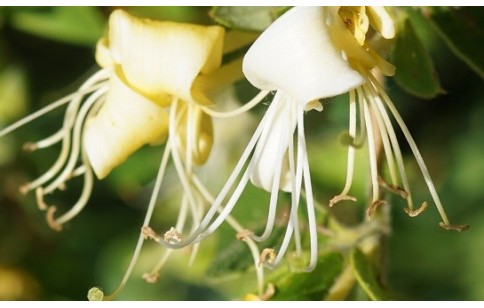- Code : #6034 S 20 mg
- Formula : C₉H₈O₄
- CAS : 331-39-5
Lonicera japonica
Lonicera japonica, “Japanese honeysuckle” in English and “Chèvrefeuille du Japon” in French, belongs to the Caprifoliaceae botanical family.
It is a climber growing to 5 m by 5 m at a fast rate, native to East Asia, found in scrub, sparse forests, mountain slopes, stony places and roadsides.
The drug, made with stems and flower buds, has long been used in traditional Chinese medicine for its many activities: alterative, antibacterial, anti-inflammatory, antispasmodic, depurative, diuretic, febrifuge. It is used for colds, fever, thirst, infections of the respiratory tract, enteritis, dysentery and skin diseases.
Its main components are : protocatechuic acid, biflavonoids, luteolin, lonicerin and chrysin, hyperoside, chlorogenic acid and caffeic acid and lonicerosides (saponins of hederagenin).

- Code : #4991 S 50 mg
- Formula : C₁₆H₁₈O₉
- CAS : 327-97-9
- Code : #1362 S 50 mg
- Formula : C₁₅H₁₀O₄
- CAS : 480-40-0
- Code : #4946 S 10 mg
- Formula : C₂₅H₂₄O₁₂
- CAS : 2450-53-5
- Code : #0035 S 20 mg
- Formula : C₃₀H₄₈O₄
- CAS : 465-99-6
- Code : #1027 S 20 mg
- Formula : C₂₁H₂₀O₁₂
- CAS : 482-36-0
- Code : #1243 S 10 mg
- Formula : C₂₁H₂₀O₁₁
- CAS : 480-10-4
- Code : #5041 S 100 mg
- Formula : C₁₀H₁₈O
- CAS : 78-70-6
- Code : #1125 S 20 mg
- Formula : C₁₅H₁₀O₆
- CAS : 491-70-3
- Code : #1126 S 20 mg
- Formula : C₂₁H₂₀O₁₁
- CAS : 5373-11-5
- Code : #1431 S 5 mg
- Formula : C₂₇H₃₀O₁₅
- CAS : 25694-72-8
- Code : #4961 S 10 mg
- Formula : C₁₆H₁₈O₉
- CAS : 906-33-2
- Code : #0918 5 mg
- Formula : C₂₈H₃₃O₁₆Cl
- CAS : 132-37-6
- Code : #6050 1 g
- Formula : C₇H₆O₄
- CAS : 99-50-3
- Code : #1327 S 20 mg
- Formula : C₂₁H₂₀O₁₂
- CAS : 482-35-9
- Code : #1139 S 50 mg
- Formula : C₂₇H₃₀O₁₆
- CAS : 153-18-4

















